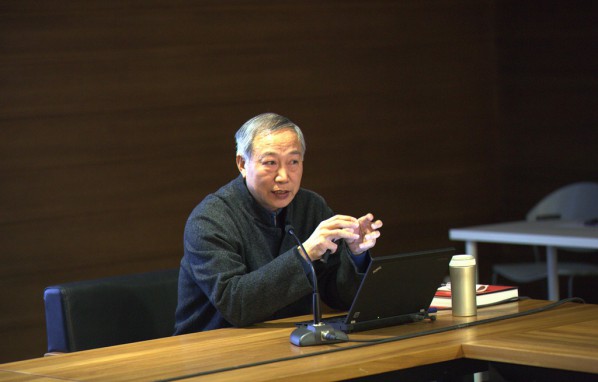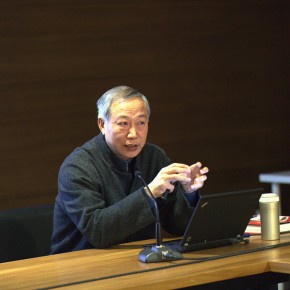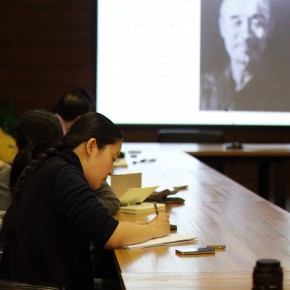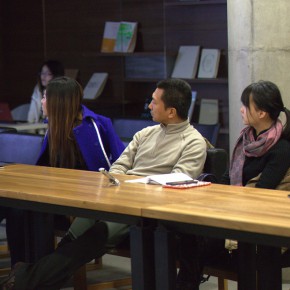
At 10:00 on January 7, 2015, the VIP room of CAFA Art Museum presented a lecture entitled “Going into Dunhuang - the Modern Transformation Tour of the Artists of Chinese Painting and Calligraphy”, the speaker was Professor Luo Shiping, Doctoral Advisor of CAFA, the lecture was also one of the academic activities of “The Oil Painting of Chinese Style – Retrospective Exhibition of Dong Xiwen” hold by CAFA Art Museum.
Dunhuang is the one of the holy lands in the mind of Chinese painters. Luo Shiping said that the discovery of Dunhuang had a significant influence on Chinese art, in the lecture he took the three outstanding Chinese artists as examples: Monk Hongyi (Li Shutong), Zhang Daqian, Dong Xiwen, who were the respective symbols of the creation of Chinese calligraphy, Chinese painting and oil painting, they did not only gain nutrients from the traditionalso owing a lot to Dunhuang, but they became the pioneers of the change of modern Chinese art. Luo Shiping said that the lecture used the three artists as an example, on the one hand, to review the Dunhuang trip of the Chinese artists, the discovery of the significance of the artists’ going into Dunhuang; on the other hand, with the painters’ trip to Dunhuang they were able to discuss what Dunhuang could bring the painter? And what art issues are associated with the modern process that were triggered?
First of all, Luo Shiping talked about the birth of Dunhuang Studies, from the discovery of the Dunhuang Cave for Preserving Scriptures in 1900, to the emergence of the later foreign explorers, now the scriptures of the Dunhuang Cave were Preserving Scriptures that were collected in Britain, France, Russia, India and China, etc. Among them, the monks copying scriptures created the “Scripture Monk Font” which had a great influence on calligraphy.
The emergence of Monk Hongyi’s “Hongyi Calligraphic Font” was not accidental, Luo Shiping said, of the three artists, Monk Hongyi was the only one who had never been to Dunhuang, but he was also under the influence of Dunhuang art. Before becoming a monk Li Shutong had been skilled in calligraphy, mainly the stone inscription rubbings and copying models of handwriting, while Hongyi became a monk, he abandoned the previous familiar style, and studied the calligraphy of “Scripture Monk Font”, Luo Shiping said that it was suitable for the character of Monk Hongyi. Monk Hongyi’s change of calligraphy style reflected the change of his individual opinion and attitude. He combined the practice of Buddhism and calligraphy, thus completely changing the font –the previous was tense, such as the rubbings of the Wei Dynasty, with the exposed tip of a writing brush, while it was slowly restrained during this period, the sentiment slowly dissipated, becoming a more introverted style. Luo Shiping concluded that, reviewing the Monk Hongyi’s process that started from an ordinary person to then be a monk, from the ordinary calligraphy to the practice of “Hongyi Font”, he made 4 contributions to the history of calligraphy: firstly, “the exposed handwriting which looked like the lines engraved on the stone”, secondly, “creating the slender font”; thirdly, “the thin and solemn style”; fourthly, “the barrier-free and harmonious realm without a stone inscription rubbing and model for copying handwriting, without a connection and separation, without length and short”.
From 1941 to 1943, Zhang Daqian went to Dunhuang to copy the murals, numbered the caves, and also created the original manuscript of the “Record of Dunhuang Grottoes”. Zhang Daqian would like to choose the murals of the Tang and Song Dynasties to copy, Luo Shiping showcased several copies by Zhang and pointed out that, comparing his copies with the original murals, the spectator would find that they were different. Luo said the reason was “that Zhang Daqian didn’t copy it, but studied it”. Dunhuang was of great significance to Zhang Daqian. During Zhang Daqian’s life, there were two different stages, first it was a change from the ancient to modern namely, he integrated his understanding into the copying of ancient art for years, to form his own painting style. The trip to Dunhuang played a key role in the process. Secondly, since going abroad he had changed from Chinese to Western, Zhang Daiqian’s creation of splash-ink rendition, splashing color was a trial that he started to think about when modernizing his painting. Luo Shiping said, “It seems to be two separated stages, but actually it has a very clear logical relationship. Even the paintingduring the later years, we can see the influence of Dunhuang still inseparably existing in his paintings.”
In 1943, Dong Xiwen quit his job and went on a long journey to Dunhuang in the Northwest of China, and stayed there for nearly three years. Until the victory of the anti-Japanese war in 1945, their first child was born in the desert and then returned to be reunited with his parents. Dong Xiwen systematically made a large number of observations and copies. Then he created the “The Kazakh Shepherdess”, which revealed he was influenced by the Dunhuang mural art. Luo Shiping compared the work with the murals of the Western Wei Dynasty in the Case 285 and Case 249 of Dunhuang Grottoes, the shaping of the shepherdess was similar to the image of the lady of the Western Wei Dynasty, and the processing technique of the distant mountains in the background was also similar to the murals of Northern Zhou Dynasty in Dunhuang. Dong Xiwen’s? best known oil painting “Founding Ceremony” was also influenced by Dunhuang art, it could be said that without the shaping foundation of the adorned style of Dunhuang murals, the bright and colorful “Founding Ceremony” was impossible to be created. Ai Zhongxin once pointed out, in the shaping of the characters of the “Founding Ceremony”, it could be seen that part of the delineating was under the influence of Dunhuang murals, the work naturally combined the expressive form of national art with the national spirit, greatly enhancing the national independence and asense of national pride, thus presenting a national style. Because of Dunhuang, Dong Xiwen was able to extract the pure quality of traditional murals, using the imagary structure to dominate the tonality of oil painting language, offering the classic paradigm for a nationalized oil painting creative method.
Luo Shiping concluded that, “Because of Dunhuang, another resource for the modern transformation of Chinese art is provided. The value of cultural resources is reflected on and used on the premise of going into, humbly studying, patiently comprehending.”
Text by Lin Jiabin, translated by Chen Peihua and edited by Sue/CAFA ART INFO
Photo by Zhang Wenzhi/CAFA ART INFO





































